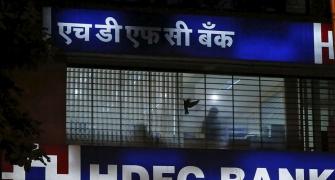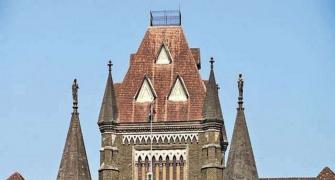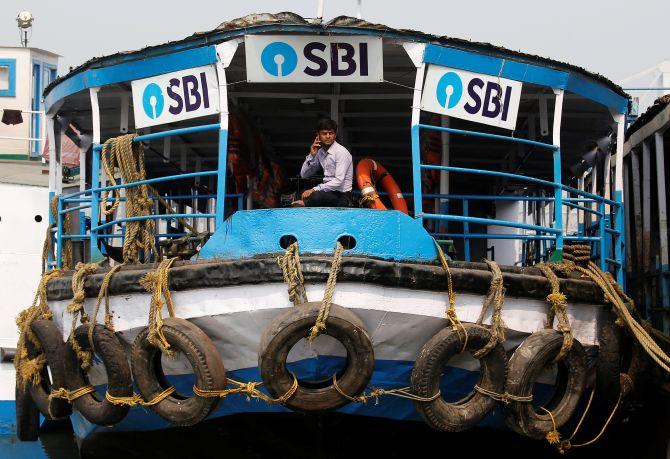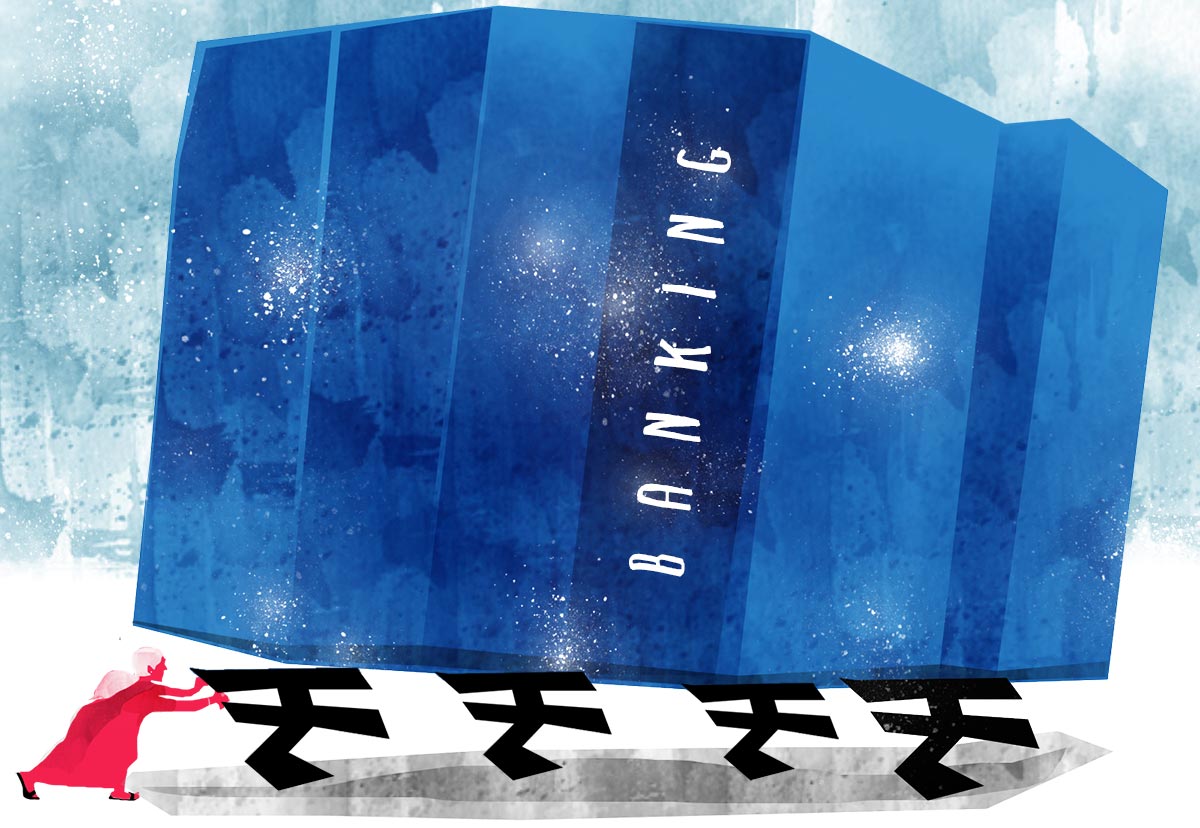We'll need to wait a couple of years to see how many restructured loans turn bad and whether some banks fall victim to their obsession for growth, explains Tamal Bandyopadhyay.
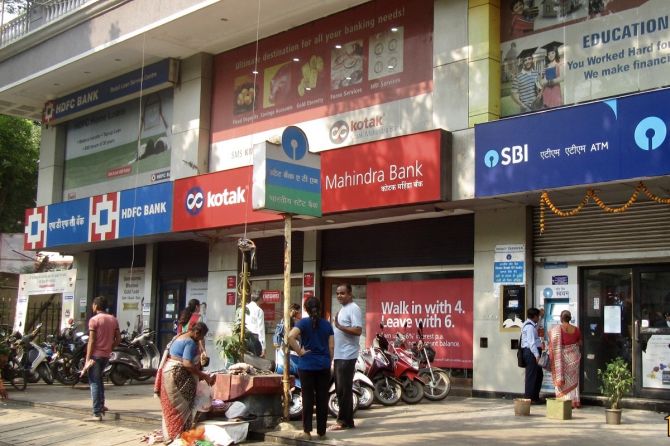
In the December quarter, public sector banks collectively recorded the highest ever net profit. The net profit of all listed banks, Rs 44,733 crore (Rs 447.33 billion), was also a record high.
If early indications are anything to go by, the March quarter will probably be even better for the Indian banking industry.
As the banks are busy crunching numbers for their FY22 balance sheets, let's take a look at how they are doing on different parameters -- some of the finer aspects of the banking system's health to gauge which banks are on the growth path and which aren't, based on their December quarter earnings.
First, the net interest margin, or NIM. This three-letter word, the difference between what a bank pays its depositors as interest and what it earns from the borrowers, is a key to profitability.
Of course, the quantum of NIM depends on the profile of the assets. For instance, a bank that gives more retail loans will always have a higher NIM than a bank focused on corporate loans. So, NIM by itself doesn't say how good or bad a bank is, and it needs to be seen along with other indicators.
Among private banks, Bandhan Bank Ltd has the highest NIM -- 7.8 per cent. It is followed by IDFC First Bank Ltd (5.9 per cent) and Catholic Syrian Bank Ltd (5.46 per cent).
Four banks have more than 4 per cent NIM: Kotak Mahindra Bank Ltd (4.62 per cent), RBL Bank Ltd (4.34 per cent), HDFC Bank Ltd and IndusInd Bank Ltd (both 4.1 per cent).
ICICI Bank Ltd's NIM is 3.96 per cent, down from 4 per cent in September 2021.
Of PSBs, Central Bank of India has the maximum NIM, 3.77 per cent. India's largest lender, State Bank of India's NIM is 3.15 per cent.
At least five other PSBs have 3 per cent or more NIM. These are Punjab & Sind Bank, Bank of Baroda, Bank of Maharashtra, Indian Bank and Union Bank of India.
By global standard, most Indian banks enjoy higher NIM, the key to which is low cost of deposits. Of course, one can have a higher NIM by charging higher interest to borrowers. Typically, unsecured loans are charged much higher interest rates than secured loans. Those banks that lend such loans have higher NIM but once such loans turn bad, recovery is not an easy task.
The composition of deposits determines the cost of money for a bank. Bulk deposits cost more and so do retail fixed deposits. Current accounts do not pay any interest, while savings accounts typically pay less interest than fixed deposits. Of course, a new bank tends to pay higher interest to woo depositors.
Simply put, the more the current and savings accounts, or CASA, with a bank, the less is the cost of deposits. That's the norm. Of course, a bank can have a pile of CASA and yet its cost of money could be pretty high since it could be paying high interest rates on SA.
Kotak Mahindra Bank has the highest CASA (59.9 per cent), followed by Jammu & Kashmir Bank Ltd (56.32 per cent), IDBI Bank Ltd (54.69 per cent) and IDFC First Bank (51.59 per cent).
HDFC Bank, which many say coined the term CASA, has 47.1 per cent, Bandhan Bank 45.6 per cent, ICICI Bank 45 per cent, Axis Bank Ltd 44 per cent and IndusInd Bank Ltd 42 per cent.
Among PSBs, BoM has the highest CASA (55.05 per cent), followed by Central Bank (50.01 per cent). SBI's CASA is 45.74 per cent and that of PNB, 45.65 per cent, and BoB's, 44.28 per cent. Indian Overseas Bank (IOB) and Indian Bank, too, have at least 40 per cent CASA.
Like NIM, CASA too by itself doesn't tell the real story as some banks are offering 2.75 per cent on savings bank deposits and a few 7 per cent.
Yet another indicator of a bank's health is the provision coverage ratio -- how much money it has set aside to take care of bad loans. IDBI Bank's provision coverage ratio is the highest among all banks -- 97.10 per cent.
Among others, CSB has 82.95 per cent, J&K Bank 81.57 per cent, ICICI Bank 79.9 per cent, Yes Bank 79.3 per cent, Karur Vysya Bank 78.8 per cent, RBL Bank 78.6 per cent and Dhanlaxmi Bank 77.5 per cent. The provision coverage ratio of the rest in this pack is less than 75 per cent.
HDFC Bank's provision coverage ratio is 71 per cent but including floating and contingent provision, it is 172 per cent of its bad loans.
BoM leads the PSB group with 93.77 per cent provision coverage ratio, followed by IOB (92.33 per cent) and Uco Bank (91.3 per cent). SBI's provision coverage ratio is 88.32 per cent and quite a few others, including BoB, P&S Bank, Indian Bank and Central Bank, have at least 85 per cent provision coverage ratio.
The provision is for bad loans. IDBI Bank has the highest gross bad loans, 20.56 per cent, followed by Yes Bank (14.65 per cent) and Bandhan Bank (10.81 per cent). Two other private banks with higher gross bad loans are J&K Bank (8.93 per cent) and Karur Vysya Bank (6.97 per cent).
Post provision, IDBI Bank's net bad loans are just 1.7 per cent, while those of Yes Bank and Bandhan Bank are 5.29 per cent and 3.01 per cent, respectively.
Among PSBs, Central Bank has the highest gross bad loans (15.16 per cent), followed by P&S Bank (14.44 per cent), PNB (12.88 per cent), Union Bank (11.62 per cent), Bank of India (10.46 per cent) and IOB (10.4 per cent).
The net bad loans of these six banks with double-digit gross bad loans vary between 4.9 per cent (PNB) and 2.63 per cent (IOB).
Yet another key health check parameter is a bank's capital adequacy ratio. On this count, there's no worry. Most banks are well capitalised.
If we imagine a bank as a human being with two legs (deposits and loans), these parameters are as important to get a sense of its health as blood pressure, blood sugar, cholesterol, bilirubin, SGPT, SGOT, serum creatinine et al are for a human being. When diagnostic tests find all these within normal range, a person is hale and hearty.
Similarly, those banks that have these parameters right, offer good RoA (return on assets) and RoE (return on equity), earn the love and affection of investors.
These figures are of the December quarter. In March, most banks will better them. Till now, the story reads well.
We need to wait for a couple of years to see how many restructured loans turn bad and whether some banks fall victim to their new-found obsession for credit growth.
Tamal Bandyopadhyay, a consulting editor with Business Standard, is an author and senior adviser to the Jana Small Finance Bank Ltd.


